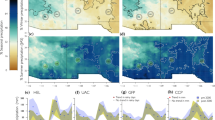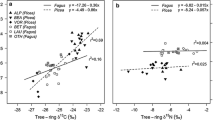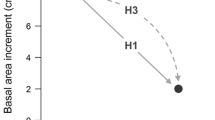Abstract
We investigated long-term responses (since 1850) of Fagus sylvatica (Luxembourg; central Europe) to shifts in temperature, precipitation, and nitrogen deposition by analyzing diameter at breast height (DBH) increment, basal area increment (BAI), and tree-ring stable isotopes (δ13C, δ15N). We compared stands on soils with contrasting water supply (Regosols and Cambisols with an available water capacity of ca. 40 and 170 mm, respectively) and of two different age classes (ca. 60 vs. 200 years). All stands showed a peak in DBH increment in the decade 1978–1987, but a decline in increment growth in subsequent decades. In addition, BAI declined in mature stands in the last two decades. Decreasing increment rates were attributable to an increasing drought limitation of stands, mainly induced by increasing temperatures in the last two decades. Contrary to our expectations, stands on Cambisols showed a similar susceptibility to shifts in temperature and precipitation as stands on Regosols, suggesting a strong adaptation of the respective ecotypes grown at dryer sites. This result was in line with long-term trends for tree-ring δ13C signatures, which did not differ significantly between stands on Cambisols and Regosols. Climate impacts on tree-ring δ15N signatures were low. High spring precipitation and temperatures caused increasing and decreasing δ15N values, respectively, but only in mature stands on Cambisols. Stands on Regosols tended to have lower δ15N values than stands on Cambisols. Decreasing δ15N values in recent decades suggest an increasing impact of allochthonous N loads with isotopically lighter N.


Similar content being viewed by others
References
AG Boden. 1994. Bodenkundliche Kartieranleitung, 3rd ed. Hannover: Schweizerbart. 392 pp.
Asman WAH, Drukker B, Janssen AJ. 1988. Modelled historical concentrations and depositions of ammonia and ammonium in Europe. Atmos Environ 22:725–35.
Biging GS, Dobbertin M. 1995. Evaluation of competition indexes in individual tree growth-models. Forest Sci 41:360–77.
Bukata AR, Kyser TK. 2007. Carbon and nitrogen isotope variations in tree-rings as records of perturbations in regional carbon and nitrogen cycles. Environ Sci Technol 41:1331–8.
Bukata AR, Kyser TK. 2008. Tree-ring elemental concentrations in oak do not necessarily passively record changes in bioavailability. Sci Total Environ 390:275–86.
Curtis CJ, Evans CD, Goodale CL, Heaton THE. 2011. What have stable isotope studies revealed about the nature and mechanisms of N saturation and nitrate leaching from semi-natural catchments? Ecosystems 14:1021–37.
Dawdy DR, Matalas NC. 1964. Statistical and probability analysis of hydrologic data, part III: analysis of variance, covariance and time series. In: Chow VT, Ed, Handbook of applied hydrology: a compendium of water-resources technology. New York: McGraw-Hill. pp 68–90.
Dittmar C, Zech W, Elling W. 2003. Growth variations of Common beech (Fagus sylvatica L.) under different climatic and environmental conditions in Europe—a dendroecological study. For Ecol Manage 173:63–78.
Dittmar C, Eissing T, Rothe A. 2012. Elevation-specific tree-ring chronologies of Norway spruce and Silver fir in Southern Germany. Dendrochronologia 30:73–83.
Drogue G, Mestre O, Hoffman L, Iffly JF, Pfister L. 2005. Recent warming in a small region with semi-oceanic climate, 1949–1998: what is the ground truth? Theoret Appl Climatol 81:1–10.
Dupouey JL, Leavitt S, Choisnel E, Jourdain S. 1993. Modelling carbon-isotope fractionation in tree-rings based on effective evapotranspiration and soil-water status. Plant, Cell Environ 16:939–47.
Duquesnay A, Breda N, Stievenard M, Dupouey JL. 1998. Changes of tree-ring δ13C and water-use efficiency of beech (Fagus sylvatica L.) in north-eastern France during the past century. Plant, Cell Environ 21:565–72.
Elhani S, Guehl JM, Nys C, Picard JF, Dupouey JL. 2005. Impact of fertilization on tree-ring δ15N and δ13C in beech stands: a retrospective analysis. Tree Physiol 25:1437–46.
Emmett BA, Kjonaas OJ, Gundersen P, Koopmans C, Tietema A, Sleep D. 1998. Natural abundance of N-15 in forests across a nitrogen deposition gradient. For Ecol Manage 101:9–18.
Falkengren-Grerup U, Michelsen A, Olsson MO, Quarmby C, Sleep D. 2004. Plant nitrate use in deciduous woodland: the relationship between leaf N, N-15 natural abundance of forbs and soil N mineralisation. Soil Biol Biochem 36:1885–91.
Francey RJ, Farquhar GD. 1982. An explanation of 13C/12C variations in tree rings. Nature 297:28–31.
Freyermuth A, Pfister L. 2010. Monographie hydro-climatologique du Luxembourg. Vol. 1 (partie texte), vol. 2 (partie annexe). Musée national d’histoire naturelle, Centre de recherche public Gabriel-Lippmmann, Administration des services techniques de l’agriculture, Société des naturalistes luxembourgeois, Luxembourg.
Friedrichs DA, Trouet V, Büntgen U, Frank DC, Esper J, Neuwirth B, Löffler J. 2009. Species-specific climate sensitivity of tree growth in Central-West Germany. Trees Struct Funct 23:729–39.
Gessler A, Keitel C, Kreuzwieser J, Matyssek R, Seiler W, Rennenberg H. 2007. Potential risks for European beech (Fagus sylvatica L.) in a changing climate. Trees Struct Funct 21:1–11.
Hari P, Arovaara H. 1988. Detecting CO2 induced enhancement in the radial increment of trees. Evidence from northern timber line. Scand J For Res 3:67–74.
Hart SC, Classen AT. 2003. Potential for assessing long-term dynamics in soil nitrogen availability from variations in δ15N of tree rings. Isot Environ Health Stud 39:15–28.
Hemming DL, Switsur VR, Waterhouse JS, Heaton THE, Carter AHC. 1998. Climate variation and the stable carbon isotope composition of tree ring cellulose: an intercomparison of Quercus robur, Fagus sylvatica and Pinus silvestris. Tellus 50B:25–33.
Hietz P, Dunisch O, Wanek W. 2010. Long-term trends in nitrogen isotope composition and nitrogen concentration in Brazilian rainforest trees suggest changes in nitrogen cycle. Environ Sci Technol 44:1191–6.
Hjellbrekke AG, Fjæraa AM. 2010. Acidifying and eutrophying compounds and particulate matter, Data Report 2008. EMEP/CCC Report 1/10. http://emep.int.
Högberg P. 1997. Tansley review No 95—N-15 natural abundance in soil-plant systems. New Phytol 137:179–203.
IPCC. 2007. Climate change 2007: the physical science basis. Contribution of working group I to the fourth assessment report of the Intergovernmental Panel on Climate Change. Cambridge: Cambridge University Press.
Iverson LR, Prasad AM. 2001. Potential changes in tree species richness and forest community types following climate change. Ecosystems 4:186–99.
Johnson SE, Abrams MD. 2009. Basal area increment trends across age classes for two long-lived tree species in the eastern U.S. In: Kaczka et al., Eds. Tree rings in Archaeology, Climatology and Ecology, Vol. 7. GFZ Potsdam: Scientific Technical Report 09/03. pp 127–34.
Kint V, Aertsen W, Campioli M, Vansteenkiste D, Delcloo A, Muys B. 2012. Radial growth change to altered regional climate and air quality in the period 1901–2008. Clim Change 115:343–363.
Krippel Y. 2005. Is the conservation of the natural and cultural heritage of sandstone landscapes guaranteed? Case study of the Petite Suisse area in Luxembourg. Ferrantia 44:147–52.
Lebourgeois F, Breda N, Ulrich E, Granier A. 2005. Climate–tree-growth relationships of European beech (Fagus sylvatica L.) in the French Permanent Plot Network (RENECOFOR). Trees Struct Funct 19:385–401.
Matthias V, Aulinger A, Quante M. 2007. Adapting CMAQ to investigate air pollution in North Sea coastal regions. Environ Model Softw 23:356–68.
McCarroll D, Loader NJ. 2004. Stable isotopes in tree rings. Quatern Sci Rev 23:771–801.
Meier IC, Leuschner C. 2008. Leaf size and leaf area index in Fagus sylvatica forests: competing effects of precipitation, temperature, and nitrogen availability. Ecosystems 11:655–69.
Mölder I, Leuschner C, Leuschner HH. 2011. δ13C signature of tree rings and radial increment of Fagus sylvatica trees as dependent on tree neighbourhood and climate. Trees Struct Funct 25:215–29.
Nock CA, Baker PJ, Wanek W, Leis A, Grabner M, Bunyavejchewin S, Hietz P. 2011. Long-term increases in intrinsic water-use efficiency do not lead to increased stem growth in a tropical monsoon forest in western Thailand. Glob Change Biol 17:1049–63.
Nordin A, Strengbom J, Witzell J, Nasholm T, Ericson L. 2005. Nitrogen deposition and the biodiversity of boreal forests: implications for the nitrogen critical load. Ambio 34:20–4.
Peñuelas J, Canadell JG, Ogaya R. 2011. Increased water-use efficiency during the 20th century did not translate into enhanced tree growth. Glob Ecol Biogeogr 20:597−608.
Peñuelas J, Hunt JM, Ogaya R, Jump AS. 2008. Twentieth century changes of tree-ring δ13C at the southern range-edge of Fagus sylvatica: increasing water-use efficiency does not avoid the growth decline induced by warming at low altitudes. Glob Change Biol 14:1076–88.
Peuke A, Rennenberg H. 2004. Carbon, nitrogen, phosphorus, and sulphur concentration and partitioning in beech ecotypes (Fagus sylvatica L.): phosphorus most affected by drought. Trees Struct Funct 18:639–48.
Pfister L, Wagner C, Vansuypeene E, Drogue G, Hoffmann L. 2005. Atlas climatique du grand-duché de Luxembourg. Luxembourg: Musée national d’histoire naturelle. 79 pp.
Poulson SR, Chamberlain CP, Friedland AJ. 1995. Nitrogen isotope variation of tree rings as a potential indicator of environmental change. Chem Geol 125:307–15.
Pretzsch H. 1999. Changes in forest growth. Forstwissenschaftliches Centralblatt 118:228–50.
Pretzsch H, Dursky J. 2002. Growth reaction of Norway spruce (Picea abies (L.) Karst.) and European beech (Fagus silvatica L.) to possible climatic changes in Germany. A sensitivity study. Forstwissenschaftliches Centralblatt 121:145–54.
Saurer M, Cherubini P, Ammann M, De Cinti B, Siegwolf R. 2004a. First detection of nitrogen from NOx in tree rings: a N-15/N-14 study near a motorway. Atmos Environ 38:2779–87.
Saurer M, Siegwolf RTW, Schweingruber FH. 2004b. Carbon isotope discrimination indicates improving water-use efficiency of trees in northern Eurasia over the last 100 years. Glob Change Biol 10:2109–20.
Saurer M, Cherubini P, Reynolds-Henne CE, Treydte KS, Anderson WT, Siegwolf RTW. 2008. An investigation of the common signal in tree ring stable isotope chronologies at temperate sites. J Geophys Res 113:1–11.
Scharnweber T, Manthey M, Criegee C, Bauwe A, Schroder C, Wilmking M. 2011. Drought matters—declining precipitation influences growth of Fagus sylvatica L. and Quercus robur L. in north-eastern Germany. For Ecol Manage 262:947–61.
Schraml C, Rennenberg H. 2002. The different reactions of beech tree (Fagus sylvatica L.) ecotypes to drought stress. Forstwissenschaftliches Centralblatt 121:59–72.
Skomarkova MV, Vaganov EA, Mund M, Knohl A, Linke P, Boerner A, Schulze ED. 2006. Inter-annual and seasonal variability of radial growth, wood density and carbon isotope ratios in tree rings of beech (Fagus sylvatica) growing in Germany and Italy. Trees Struct Funct 20:571–86.
Stan AB, Daniels LD. 2010. Calibrating the radial-growth averaging method for detecting releases in old-growth forests of British Columbia, Canada. Dendrochronologia 28:135–47.
Steubing L, Fangmeier A. 1992. Pflanzenökologisches Praktikum. Berlin: Parey Verlag. 205 pp.
Sun F, Kuang Y, Wen D, Xu Z, Li J, Zuo W, Hou E. 2010. Long-term tree growth rate, water use efficiency, and tree ring nitrogen isotope composition of Pinus massoniana L. in response to global climate change and local nitrogen deposition in Southern China. J Soil Sediments 10:1453–65.
Treydte K, Schleser GH, Schweingruber FH, Winiger M. 2001. The climatic significance of δ13C in subalpine spruces (Lötschental/Swiss Alps)—a case study with respect to altitude, exposure and soil moisture. Tellus 53B:593–611.
Trouet V, Esper J, Beeckman H. 2010. Climate–growth relationships of Brachystegia spiciformis from the miombo woodland in south central Africa. Dendrochronologia 28:161–72.
Weiner J, Thomas SC. 2001. The nature of tree growth and the age-related decline in forest productivity. Oikos 94:374–6.
WRB – IUSS Working Group. 2006. World reference base for soil resources, 2nd edn. World Soil Resources Reports No. 103. Rome: FAO.
Yamaguchi DK. 1991. A simple method for cross-dating increment cores from living trees. Can J For Res 21:414–16.
Zerbe S. 2002. Restoration of natural broad-leaved woodland in Central Europe on sites with coniferous forest plantations. For Ecol Manage 167:27–42.
Author information
Authors and Affiliations
Corresponding author
Additional information
Author Contributions
WH, TN, and GvO conceived of the study and study design, performed parts of the research, analyzed data, and wrote the paper. UF, BN, and LP contributed new methods and models, analyzed data, and contributed to writing of the paper. All other authors performed parts of the research, contributed to data analyses, and to writing of the paper.
Rights and permissions
About this article
Cite this article
Härdtle, W., Niemeyer, T., Assmann, T. et al. Long-Term Trends in Tree-Ring Width and Isotope Signatures (δ13C, δ15N) of Fagus sylvatica L. on Soils with Contrasting Water Supply. Ecosystems 16, 1413–1428 (2013). https://doi.org/10.1007/s10021-013-9692-x
Received:
Accepted:
Published:
Issue Date:
DOI: https://doi.org/10.1007/s10021-013-9692-x




